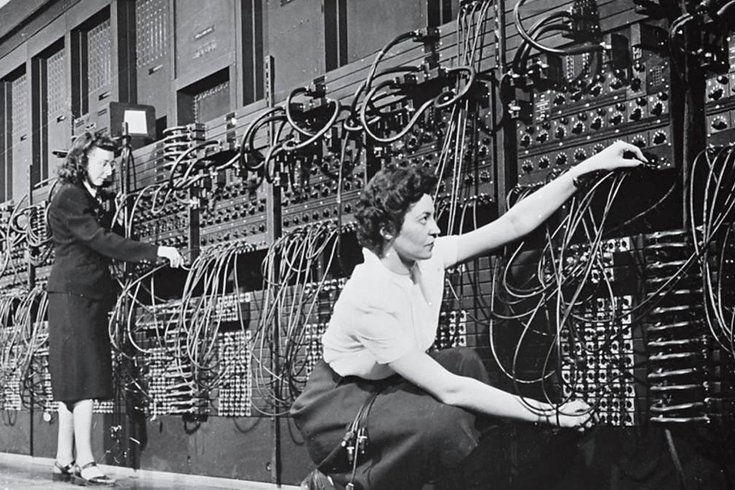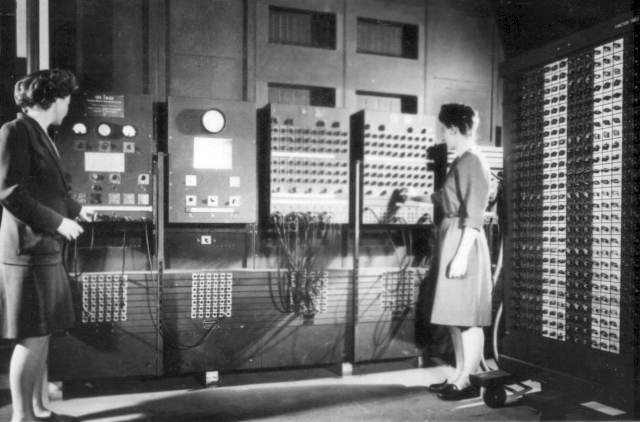
February 11, 2016
 Source/Los Alamos
Source/Los Alamos
ENIAC, the world's first digital computer, unveiled 70 years ago Sunday at the University of Pennsylvania, had six primary programmers: Kay McNulty, Betty Jennings, Betty Snyder, Marlyn Wescoff, Fran Bilas and Ruth Lichterman. They were initially called "operators."
For most of us born with both feet firmly planted in the information age, it's far too easy to take modern computers and the internet for granted. We'll complain about the latest comic book movie's less-than-perfect CGI, sigh loudly if our movie doesn't load instantly on Netflix, and we can't even imagine life without smartphones anymore.
“They stepped in to do a job that they didn't understand, that nobody understood. So they had to invent, discover, and learn how to work this machine without any real training. In that sense, they were real trailblazers.” – Bill Mauchly of Berwyn, son of one of the original six programmers
But in the early 1940s, before the dawn of the Digital Revolution, only a handful of computers existed in the entire world. These were built and owned by large research institutions like Harvard University and Bell Laboratories, and ran about a billion times slower than today's computers. Even the word “computers” back then commonly referred not to machines, but to people — mostly women who used adding machines to calculate ballistics trajectories during wartime. Some of those calculations could take up to 12 hours on an adding machine. ENIAC would reduce that to 30 seconds.
In 1945, the U.S. Army recruited six women working as artillery trajectory computers at the University of Pennsylvania to work full-time on a secret government project. For the next year, they used their creativity, tenacity and solid backgrounds in mathematics to become the original programmers of the world's first electronic general-purpose computer, called ENIAC.
“These women were hired pretty much to set this machine up, but it turns out that no one knew how to program. There were no 'programmers' at that time, and the only thing that existed for this machine were the schematics,” said Mitch Marcus, the RCA Professor of Artificial Intelligence in the Department of Computer and Information Science at the University of Pennsylvania. “These six women found out what it took to run this computer — and they really did incredible things.”
Computing technology took a crucial step forward with the birth of the Electronic Numerical Integrator And Computer, or ENIAC, at the University of Pennsylvania in 1946. Seventy years ago on Sunday, February 14, 1946, physicist John Mauchly and electrical engineer J. Presper Eckert revealed to the public their breakthrough creation to much fanfare. (February 15, the day ENIAC was formally dedicated, is recognized as “ENIAC Day” by the Philadelphia City Council)
“So ENIAC, instead of doing five additions a second [like its predecessors], each of its 20 accumulators could do 20,000 additions a second,” said Marcus, who has pursued ENIAC as a side interest for more than two decades. “When it was finished, it could actually compute the trajectory of an artillery shell faster than the artillery shell could travel.”
Not only was ENIAC incredibly powerful in terms of speed, but unlike earlier machines, it wasn't built for a specific purpose and could tackle a multitude of different problems. Mauchly's original proposal was to use it for weather forecasting, but the U.S. Army later funded the project for the purpose of automating the calculation of artillery firing tables. Each line of these tables typically took a single person about 40 hours to complete.
ENIAC, and its raw computing power, was noticed soon thereafter by John Von Neumann, a mathematician working on a top secret project at Los Alamos. In fact, ENIAC's first "job," enabled by its versatile architecture, was to perform calculations to design and build the hydrogen bomb.
Using present-day technology, ENIAC's design and functionality can be recreated on a tiny chip less than a tenth of the size of a postage stamp. (For the computer's 50th anniversary, ENIAC-on-a-chip was actually made by a team of students led by Penn Engineering professor Jan van der Spiegel in 1996.) But the early machine took up an entire room and consisted of refrigerator-sized panels fitted with 17,468 vacuum tubes, 7,200 crystal diodes, 1,500 relays, 70,000 resistors, 10,000 capacitors, and about 5 million hand-soldered joints. It cost about $500,000 to build (about $6 million today).
“I've thought about what it must have been like to stand inside that huge computer. There would be the smell of hot electronics, and it was the first machine that didn't have things clacking, so it was just a giant humming machine,” said Bill Mauchly, the son of John Mauchly and one of the six original ENIAC programmers, Kathleen McNulty Mauchly Antonelli. “And it had this light show that was unprecedented — like being in a cathedral or something.”
Construction of the 27-ton, 680-square-foot behemoth began in July 1943, including the fabrication of ENIAC's 20 accumulators — basically these were electronic adding machines responsible for taking numbers in and performing part of a calculation. To perform a multistep calculation, these units had to be wired up with large cables and trays used to carry perfectly-timed pulses from one accumulator to another.
Thus, programming ENIAC was a complicated exercise in digital choreography for the six women recruited for the job. Joining Antonelli on the project were Betty Snyder Holberton, Jean Jennings Bartik, Marlyn Wescoff Meltzer, Ruth Lichterman Teitelbaum, and Frances Bilas Spence. The feat was made even more challenging by the fact that no one in the world had ever done anything quite like this before.
“They stepped in to do a job that they didn't understand, that nobody understood,” said Bill Mauchly, a Berwyn resident who hopes to put together a Philadelphia-area museum honoring ENIAC. “So they had to invent, discover, and learn how to work this machine without any real training. In that sense, they were real trailblazers.”
He believes they were probably the first people to have “programmer” as a job title, even though it was nothing like the occupation of today. Babysitting this giant, complex computer was very physical work, requiring them to haul cables and trays to different parts of the room-sized machine to get it to run programs correctly. They would even crawl inside the hug structure to fix faulty links and bad tubes.
Programmers Betty Jean Jennings, left, and Fran Bilas operate ENIAC's main control panel at the Moore School of Electrical Engineering at the University of Pennsylvania.
But the programmers' accomplishments and vast knowledge of the machine wasn't recognized at the time due to a stigma that existed about women not belonging in a mathematics environment outside of the “clerical” human computer work. For instance, Holberton was told by her undergraduate math professor that she should be out getting married and having babies instead of being in the classroom. Despite the discouragement she experienced early on, Holberton became one of the most skilled ENIAC programmers and stayed in computer science long afterwards, making key contributions to the first commercial computer produced in the United States (UNIVAC), sorting algorithms, and one of the earliest high-level programming languages (COBOL).
“The women were viewed as operators of the machine. They were there to help men figure out how to use the computer and were given basically no credit, and their role was entirely minimized." – Mitch Marcus, RCA professor of artificial intelligence at Penn
“The first time I talked to Betty Holberton, who wrote the demo program for [the Feb. 15 ENIAC public unveiling], she said to me, 'There was this big dinner that night, and we girls were not even invited,'” said Marcus, who had confirmed this fact earlier by looking at the guest list in the Smithsonian archives. “The women were viewed as operators of the machine. They were there to help men figure out how to use the computer and were given basically no credit, and their role was entirely minimized. The fact that they weren't invited to the dinner is pretty telling, I think.”
In the last decade or so, their contributions to ENIAC have finally come to light through articles, books, and a documentary short film. Mauchly notes that after his father's death in 1980, his mother initially started speaking publicly about his work in the project — but after realizing the women's vital accomplishments, institutions wanted to know more about ENIAC from her point of view.
“Her involvement in the project started to come out, so then later, her talks started to center more on her role,” said Mauchly, who also worked in computer engineering for most of his life. “It wasn't that my mom thought out of the box — rather, she said, 'What box?' She didn't really see obstacles and wasn't afraid to try new things.”
Today, anybody with an Internet connection has dozens of free online programming courses to choose from on websites like Codeacademy, Coursera, and Khan Academy. The ability to learn computer programming is now available to the masses and valued as a highly coveted skill — a development set in motion by the six pioneering women that dared to take some of the very first steps.
 Staff/PhillyVoice
Staff/PhillyVoice U.S. Army/ARL Technical Library archives
U.S. Army/ARL Technical Library archives